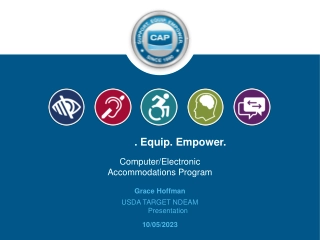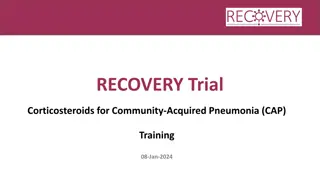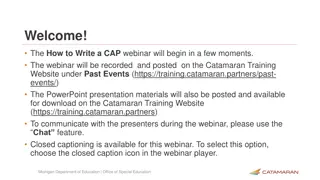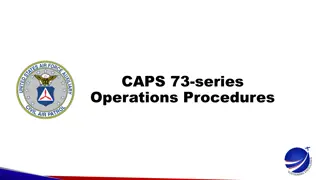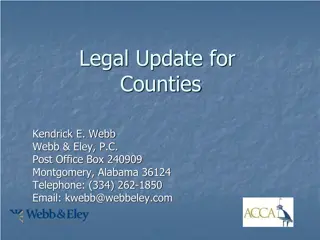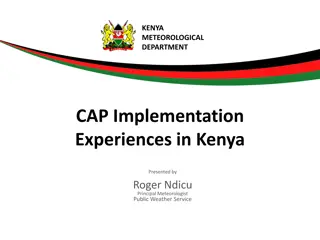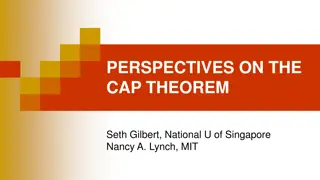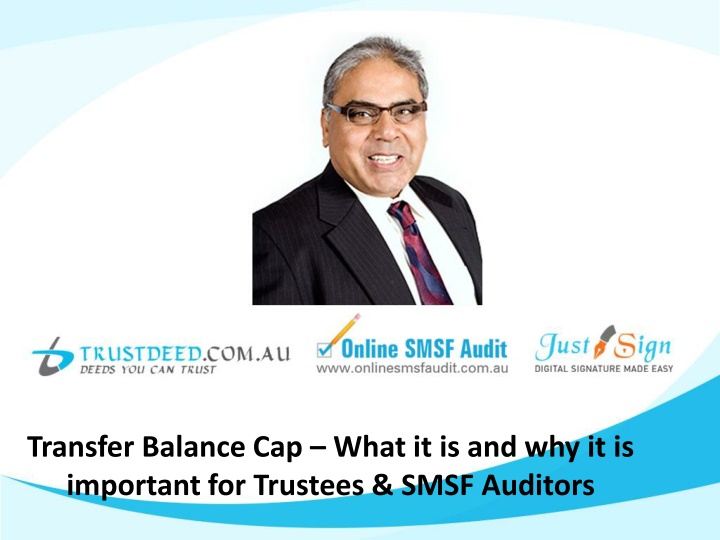
Importance of Transfer Balance Cap for Trustees and SMSF Auditors
Learn about the Transfer Balance Cap and why it is crucial for Trustees and SMSF Auditors. Explore topics such as death benefit pensions, reversionary pensions, and estate planning implications for TRISs. Gain insights into managing liquidity crunch on the death of a spouse and converting existing pensions into automatically reversionary pensions.
Download Presentation

Please find below an Image/Link to download the presentation.
The content on the website is provided AS IS for your information and personal use only. It may not be sold, licensed, or shared on other websites without obtaining consent from the author. If you encounter any issues during the download, it is possible that the publisher has removed the file from their server.
You are allowed to download the files provided on this website for personal or commercial use, subject to the condition that they are used lawfully. All files are the property of their respective owners.
The content on the website is provided AS IS for your information and personal use only. It may not be sold, licensed, or shared on other websites without obtaining consent from the author.
E N D
Presentation Transcript
Transfer Balance Cap What it is and why it is important for Trustees & SMSF Auditors
House Keeping - Audio If Computer sound is not audio able 1. Phone the number on your panel 2. Enter Access Code
House Keeping Hand Out Copy of this Presentation can be downloaded From the Panel
House Keeping Questions on this Presentation If you have any Questions on this Presentation 1. Type in your questions in the panel 2. Speaker will answer all your questions after the presentation
Disclaimer of Legal & Financial Advice - Educational Purpose Only Statement This paper represents the opinion of the author (s) and not necessarily those of Deed Dot Com Dot Au Pty Ltd. The contents are for general information only. They are not intended as professional advice - for that you should consult a Accountant or other suitably qualified professional. Deed Dot Com dot Au Pty Ltd expressly disclaims all liability for any loss or damage arising from reliance upon any information in this presentation. Disclaimer The information contained in this presentation is based on the understanding of the author has of the relevant Australian laws as at 04th May 2021. As these laws are subject to change you should refer to ATO s website or talk to a professional adviser for the most up-to-date information. The information is for adviser use only and is not a substitute for investors seeking advice. While all care has been taken in the preparation of this document (using sources believed to be reliable and accurate), no person, including Deed Dot Com Dot Au Pty Ltd, accepts responsibility for any loss suffered by any person arising from reliance on this information. This update is not financial product advice and does not take into account any individual s objectives, financial situation or needs. Any examples are for illustrative purposes only and actual risks and benefits will vary depending on each investor s individual circumstances. You should form your own opinion and take your own legal, taxation and financial advice on the application of the information to your business and your clients.
AGENDA Transfer Balance Cap 1. How the transfer balance cap works for death benefits? 2. Death benefit pensions Vs reversionary pensions 3. Why should existing pensions be converted into automatically reversionary pensions? 4. Dealing with the liquidity crunch on the death of the first spouse including in-specie death benefit payments 5. Implications for estate planning for TRISs
Overview When one in a couple dies Large amounts of family wealth in super will exit the super environment to avoid adult kids paying tax upon death of the 2nd in a couple Survivor s pension may need to be commuted to accumulation to accept reversionary pension Since there is a Transfer balance Cap Reversionary pensions and BDBN s both will be required If you do not have reversionary pension consider amending the SMSF deed so that an existing pension can become a reversionary pension
How the transfer balance cap works for death benefits? SISR 6.21 : If you have a superannuation interest when you die, your death creates a compulsory cashing requirement for the superannuation provider - to your beneficiaries or to your legal personal representative as soon as practicable. For dependant beneficiaries, superannuation death benefits can be cashed: SISR 6.21 (2) (a) as a superannuation lump sum that is paid out of the superannuation system, SISR 6,21 (2) (b) as death benefit income streams that are retained in the superannuation system (from 1 July 2017 such superannuation income streams must also be in the retirement phase), or a combination of the two. For non- dependant beneficiaries or your legal personal representative, superannuation death benefits can only be cashed as a superannuation lump sum that is paid out of the superannuation system
Who is a dependent SISR 6.21 (2A) Death benefit income stream, a dependant beneficiary is a dependant of the deceased member, which includes: a spouse a child under 18 years of age a financially dependent child who is under 25 a child who is disabled irrespective of their age, and a person who was in an interdependency relationship with the deceased (Sec 10A of SISA)
How dependent get affected by Balance Transfer Cap - Section 294 -25(1) of ITAA Where the deceased member s interest is retained within the superannuation system and cashed to a dependant beneficiary in the form of a death benefit income stream, a credit arises in the dependant beneficiary s transfer balance account. A death benefit income stream can either be reversionary or non- reversionary Note: Once Total Superannuation Balance (Not Transfer Balance Cap) has reached $1.7 M (from 1st July 2021) No more non-concessional contributions allowed.
Reversionary Pension Vs Non- Reversionary Pension Conditions: 1 A reversionary death benefit income stream is a superannuation income stream that reverts to the reversionary beneficiary automatically upon the member s death Put in place - prior to the member s death . Reverts because the governing rules or the agreement under which the superannuation income stream is provided expressly provides for reversion Reverts not because the trustee exercising a power or discretion to determine a benefit in the beneficiary s favour or it is mentioned in the Binding Death Benefit Nomination (BDBN) Or 2. superannuation income stream ceases on the member s death.
Non- Reversionary Death Benefit Pensions A non-reversionary death benefit income stream is a new superannuation income stream created and paid to the dependant beneficiary or beneficiaries. Conditions: If the trustee has the power or discretion to determine: to whom the death benefit is paid the form in which the death benefit will be paid (for example as a superannuation lump sum or a superannuation income stream), or the amount of the death benefit paid.
Non- Reversionary Death Benefit Pension 1st July 2005 19th May 2009 10th Sept. 2020 15th Oct. 2020 Trustee can pay a Death Benefit as a pension only If the power and / or Discretion to pay a death Benefit as a pension Or it must pay a death benefit Lump Sum Harry Commences Pension (Non-Reversionary) Harry Dies Pension Ceases Harry lodges BDBN to Trustee to pay super To his wife Mary Mary Requests Trustees to pay Harry s Super As a Death Benefit Pension
Administrative steps Paying a Death Benefit 1. 2. 3. Confirming that the reversionary beneficiary is a dependant beneficiary Obtaining bank account details Adding them a member of the SMSF if not a member
Death benefit pensions Vs reversionary pensions Transfer balance credit arises in your transfer balance account (Section 294-25(1) of ITAA) in both cases as the death benefit pension is in retirement phase from 1st July 17 The time at which the credit arises for reversionary pension is: (a) for death benefit income streams commencing before 1 July 2017 the later of 1 July 2017 or 12 months from the day the death benefit income stream first became payable, and (b) for death benefit income streams commencing on or after 1 July 2017 12 months from the day (the starting day) when you started to be the retirement phase recipient of the death benefit income stream
Reversionary Pension and Transfer Balance Cap The transfer balance credit that arises in your transfer balance account as a result of receiving a death benefit income stream may cause you to exceed your transfer balance cap So that you no longer exceed your transfer balance cap you can choose: 1) Commute fully or partially the death benefit income stream (cannot be retained as an accumulation phase interest and the commuted amount must be paid out of the superannuation system to you as a death benefit superannuation lump sum) or, 2) Commute fully or partially your own income stream (If you have one, in the retirement phase to remain within the superannuation system as an accumulation phase interest)
Harry has a reversionary Pension Beneficiary is his wife Mary At the time of his death on 1st Sept. 2020 Pension Balance $1,200,000 Nil Balance TBC $1.6M Harry $1.2M Pension Mary s Pension Balance on 1st Sept. 2020 $900,000 (commencing amount) 1st Sept. 2020 Mary $900K Pension Transfer Balance Credit of $1,200,000 Will arise for reversionary death benefit Income stream on 1st Sept 2021 (12 months from Harry s death) Harry $1.2M Pension Mary $900K Pension 1st Sept 2021 If Mary does nothing before 1st Sept. 2021 her transfer balance On 1st Sept. 2021 will be $2,100,000 and will exceed her transfer balance cap ($1,700,000) Excess by $400,000
Option 1 Partially Commute Harry reversionary Pension and take this as a death benefit lump sum out of the superannuation System TBC $1.7M 1st Sept. 2020 Harry $1.2M Pension Mary $900K Pension DEATH BENEFIT MUST BE PAID OUT Harry $400K Pension 1st Sept. 2021 Harry $800K Pension Mary $900K Pension Mary s Bank Account $400K
Option 2 Partially Commute Own Pension and take this out of the superannuation System Debit of $400K in Transfer Balance Account Credit of Reversionary Pension of $1,200,000 in Transfer Balance Account TBC $1.7M 1st Sept. 2020 Harry $1.2M Pension Mary $900K Pension Mary s $400K Pension 1st Sept. 2021 Mary $500K Pension Harry $1.2M Pension Mary s Bank Account $400K
TBC $1.7M 1st Sept. 2020 Option 3 Partially Commute Own Pension and transferring the amount to an accumulation phase interest and leaving it in the superannuation System Harry $1.2M Pension Mary $900K Pension Mary s $400K Accumulation Account Commutation is a debit to transfer balance account of $400,000 1st Sept. 2021 Credit of Reversionary Pension of $1,200,000 Harry $1.2M Pension Mary $500K Pension
Large DEATH BENEFIT MUST BE PAID OUT Option 1 Pay out to Death Benefit Beneficiary. TBC $1.7M 1st Sept. 2020 Harry $1.7M Pension (Commenced at $1.6M) Harry $1.7M Pension 1st Sept. 2021 Mary s Mary s $1.9M Pension (Commenced at $1.6M) Bank Account $1.7M
Retain Maximum in Super TBC $1.7M Procedure to Follow Step 1. Full commutation of a pension Debit of $1.9M or minus $300K to her transfer balance account Harry $1.7M Pension (Commenced from $1.6M) 1st Sept. 2020 Mary s $1.9M Pension (Commenced from $1.6M) Step 2. Harry s Reversionary Pension will credit her Balance Transfer Account by $1.7M her account will be move from Minus $300K to Plus $1.4M Debit Transfer Balance (-$1.9M) Negative $300K She cannot add another $100K from her Accumulation Account to make to $1.7M maximum TBC As 100 % of initial BTC is exhausted highest ever TBC 1st Sept. 2021 Harry $1.7M Pension She will then have $1.7M Pension and a $1.9 Million Accumulation account which is where she was at the time of Harry s Death Mary s $1.9 M Accumulation Account
Increase in Transfer Balance Cap to $1.7M from 1st July 2021 Pension Commenced at $600K = Highest ever TBC Gap = 600/$1.6M = 37.50% or Gap is 62.50% Increase in Balance in transfer balance cap $100K (From $1.6M to $1.7m) Old Gap $1.6M - $600K = $1M Increase 100K X 62.50% Total Gap = $1,062,500
Retain Maximum in Super Maximum if Harry s which can be absorbed by Mary Harry $1.7M Pension (Commenced from $600K) 1st Sept. 2020 Own Pension $600K Harry Pension $1,062,500 Total $1,662,500 Mary s $1.9M Pension (Commenced from $600K) Balance of Harry s Pension must be taken out 1st Sept. 2021 Harry $1,062,500 Pension Must Withdraw $637,500 TBC $1,662.5 Mary s $1.9M Pension (Commenced from $600K)
12 Month delay with TBC Credits Pension account balance on date of death matters not the balance after 12 months In our example if Harry died one year back and had only $1.7M in the pension account Mary has 12 months from date of death to adjust her account If there is an increase or Decrease from $1.7M it does not matter Any Increase in Harry s pension balance will be tax free in the fund as the pension has not ceased till it is reverted or paid out Increases can be Investment Earnings Life Insurance Claims
Why should existing pensions be converted into automatic reversionary pensions? If the survivor wants to keep maximum money in super and pay either no tax or tax at concession rate of 15% Steps to take - If the existing pension is not reversionary Update trust deed & Update Pension documents: which can allow to convert an existing pension to a reversionary pension instead Or Re-booting the pension can be dangerous due to Centrelink Grandfathering and deeming provisions
Dealing with the liquidity crunch on the death of the first spouse including in-specie death benefit payments If Pensions are non-reversionary Cash / Assets of the fund can be paid out as a Lump Sum Balance of the deceased member has to match the assets of the fund (Problems: only one lumpy asset property)
Implications for estate planning for TRISs TRIS is in Accumulation Phase Cannot be reverted only Death Benefit Pension Withdrawal of minimum amount is not required before the death of the member (In any case income supporting pensions assets pay 15% tax) Trustee discretion is a must to commence a death benefit pension or BDBN must request the trustee to commence a pension instead a Lump Sum Update your trust deed Trustees and Advisor does not know what to do
Key issues, actions and strategies for Auditors Implications: other tax structures like companies structures Large SMSF s will pay tax as some money will be in Accumulation Phase or Client wealth may exit superannuation system sooner Increase activity in Discretionary Trusts and Re-contribution Strategy may not be possible because Total Superannuation Balance will restrict the amount which can be contributed in Super Higher tax will be paid by non-dependents on death of parents because Not all assets will be supporting a tax-free component pension Higher taxable component in Death Benefit Lump Sum payments
Income of the Fund $210,000 TBC $1.7M Credited to member accounts in proportion of Taxable / Tax free Component Mary $500K Pension Harry $1.2M Pension Income $160K Credited to the fund as Taxable Component Irrespective of what the components are of the Accumulation Account Income is 100% Taxable component Mary s $500K Accumulatio n Account Income $50K
Key issues, actions and strategies for Auditors Withdrawal from Superannuation System Survivor of Couple Single member fund has only Adult Children Statistics : In most cases : 2nd dies within 5 years of 1st Lumpy Assets in the fund High Taxable component Income outside of Super can also be tax free Say up to $40K per year Discretionary Trust also offers asset protection Insurance Bond Tax Free after 10 Years Just spend the money
Key issues, actions and strategies for Auditors Reversionary Pensions Vs BDBN Reversionary Pensions controls only the Retirement Phase BDBN controls the Accumulation Account Reversionary Pensions AND BDBN Both Required
Mental Capacity Can make decisions only if Mentally capable = Financial Power of Attorney If Mental Capacity is Lost Application in the guardianship tribunal Legal Costs Some Hard Wire clauses in the SMSF deed for early withdrawal Terminal illness Entering nursing Home Doctors decision based on Mental Health
Advisor Strategy Consideration 1. What does the client want ? no two clients are the same 2. What are the taxable / tax free components of each pension? 3. Are there any Dependents who can receive reversionary beneficiaries? 4. Can they re-contribute Has bring forward rule been triggered in the previous two years? 5. After first one s death does the survivor wants to retain money in super or withdraw? 6. Does the fund own Properties in the fund (Lumpy Assets)? 7. Are there Loans (LRBA s) in the fund which may have to be paid out? 8. Has the fund invested in Private companies or Pre- 99 Trusts?
Announcements Justsign.com.au for Free Price Increase from 1st July 2021 100 150 Funds Single Plan Valued $770 200 300 Funds Small Plan Valued $880 300 + Funds Enterprise Plan Valued $990 1 or 5 10 - 25 50 300 500 2000 4,000 From $17 to $25 $4 $3 $2 No Change Commencing from 1st July 2021
For further Enquires please visit our websites: www.trustdeed.com.au www.onlinesmsfaudit.com.au www.justsign.com.au and chat with our agent. Alternatively, you - contact us 0296844199 or Email us at sales@trustdeed.com.au sales@onlinesmsfaudit.com.au sales@justsign.com.au

